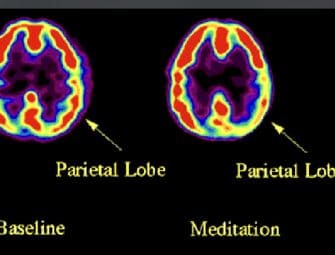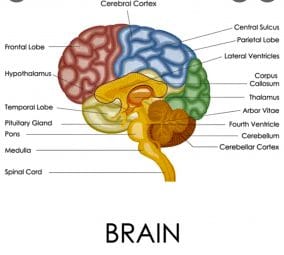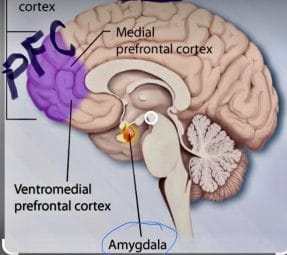“Becoming Mindful of the Brain & its Functions”
Rebecca Gladding M.D., author of ‘You Are Not Your Brain’ wrote: “The brain, and how we are able to mold it, is fascinating and nothing short of amazing.” Backed by thousands of studies, meditation is the neuroscientific community’s most proven way to ‘upgrade’ the human brain.
I read a few articles & scientific papers on ‘How Meditation changes the Brain & Behaviour’, & started noting important findings for myself.
That the brain changes physically when we learn a new skill, like arranging a Rubik’s cube or playing a musical instrument, has been known for over a decade. Previous studies had suggested that meditation does something similar for parts of the brain involved in focused attention.
1. Meditation balances the brain – Human brain has two hemispheres, left and right. According to Dr. Roger Sperry’s Nobel Prize winning ‘split brain’ studies, like a dominant hand, most of us heavily favor one side of our brain. Brain imaging studies have shown that highly successful, massively creative people use both brain halves in a much more balanced and integrated way than the rest of us. Neuroscientists have recently learned that highly creative people are actually ‘whole brain’ thinkers rather than just ‘right brain’ thinkers. A 2012 UCLA School of Medicine study found that the ‘corpus callosum’ the cable of nerves cross-linking the brain hemispheres, was remarkably stronger, thicker, and more well connected in meditation practitioners. By constructing a ‘hyper connected,’ ‘ultra efficient’ bridge between our brain halves, meditation puts an abrupt end to our ‘cerebral hemisphere war’. Meditation leads to integrating our ‘right’ and ‘left’ brain hemispheres after a lifetime of separation & conflict. Harmonizing both brain hemispheres opens the door to a variety of benefits, with better focus, deeper thought, lasting serenity, enhanced creativity, excellent mental health & enhanced memory.
2. Meditation ends depression– Meditation is comparable to medications in preventing relapse in cases of clinical depression. A landmark Washington University School of Medicine study (Sheline et al, 1999) demonstrated shrunk (atrophied) ‘hippocampi’, evident in brain MRI, of women having major clinical depression. The Hippocampus of females depressed since longer duration were more atrophied as compared to cases having recent depression. Researchers have demonstrated that, after only 8 weeks of meditation, the left and right ‘hippocampi’ of participants had significantly grown in neural thickness, density, and overall size. This amazing finding means that meditation can reverse depression & make the brain resilient to stress.
3. Meditation improves memory & learning – The hippocampus is the most crucial part of human brain for memory & learning. One of the most prominent neuroscientists in the world, Harvard University’s Dr. Sara Lazar and colleagues have studied the meditating brain for decades. Among a long list of healthy brain discoveries, her research shows that meditation dramatically increases ‘hippocampal cortical thickness,’ with magnitude determined by duration of practice.
4. Meditation helps to overcome loneliness – “Meditation is your best friend”. Dr. Andrew Newberg, University of Pennsylvania scientist, took brain images of Tibetan monks during meditation. As expected, their ‘highly intelligent’ frontal lobes lit up, just like countless other studies had shown. However, the interesting finding was that the meditators’ ‘third dimensional’ based parietal lobes cooled off immensely, which is the same area that loneliness and social isolation brings to a boil. Meditation deactivates parietal lobes. By making one feel connected to everyone and everything as the meditator loses its sense of self, feeling a sense of oneness, meditation cancels out the detrimental mental, emotional, and physical effects of loneliness. While friends come and go, meditation will always be there for you.
5. Meditation instills compassion & kindness -According to the latest science, true happiness comes from practicing compassion & kindness. It is when we help our fellow beings, when we feel connected to the world, when we give expecting nothing in return, when we are kind just to be kind the world becomes a better place. In fact, a brain imaging study showed that, when we donate to charity, our brain’s ‘pleasure center’ lights up like the full moon on a clear night. Practicing compassion and kindness opens the door to a host of health benefits. like longevity, reduced anxiety & depression, better immunity etc. It reminds me of the saying, ‘Give… and you shall receive.’ It all starts with the brain. A highly cited UCLA School of Medicine study found that the ‘right anterior dorsal insula’ of meditators is highly active during the session. This is the same brain area that lights up like a Christmas tree when we practice kindness & compassion. Meditation activates right anterior insula. No wonder that many of history’s greatest humanitarians were also meditators, Om Swamiji being no exception. But, I wonder is the reverse also true, that souls which are kind & compassionate become illustrious meditators. I believe both go hand in hand.
6. Meditation boosts emotional quotient – ‘IQ gets you hired. EQ gets you promoted.” — Time Magazine. In 1996, a world-renowned psychologist, Dr. Daniel Goleman, published a groundbreaking book ‘Emotional Intelligence – Why it can matter more than IQ’ that turned the tables. In 2013, with the goal of mapping out the ‘EQ’ regions of the brain, University of Illinois researchers CT scanned 152 Vietnam veterans engaging in ‘emotionally intelligent’ centered activities, like (in-person) social interaction. The brain map imaging showed one particular region, the ‘temporoparietal junction (TPJ)’ to be especially important. ‘temporoparietal junction’ is now known as the “EQ command and control center,”. In 2016, a team of Spanish and German researchers (Yang et al) fMRI imaged the brains of 13 novice meditators, before and after 40 days of mindfulness training. In addition to massively reducing their anxiety and depression scores (as illustrated by countless other studies), in just six short weeks, the ‘internal consistency’ of their temporoparietal junction (TPJ) was significantly increased. By strengthening the brain’s ‘EQ command & control center,’ meditation opens the door to a wonderful and especially important bundle of traits: self awareness, adaptability, empathy, conscientiousness, self-motivation, all these translating into a better emotional balance. Meditation is COOL :).
7. Meditation Transforms Stress Response & Reduces Anxiety ( The Amygdala Hijack)– Human Brain has a deep wired negative bias, much like its stone age ancestors. Human beings in the pre historic era lived in deep forest caves, an extremely hostile environment, fearing for their & loved ones lives due to wild animals. They depended on hunting for their food as farming was unknown to them. Our stone-age ancestors had a very dominant ‘fight or flight’ fear response, which conferred a survival advantage to them. This ‘fight or flight’ fear response, still looms large in our heads courtesy our oversized ‘amygdala.’ The amygdala is a collection of cells near the base of the brain. There are two, one in each hemisphere or side of the brain. This is where emotions are given meaning, remembered, and attached to associations and responses to them (emotional memories). When we feel threatened and afraid, the amygdala automatically activates the fight or flight response by sending out signals to release stress hormones that prepare our body to fight or run away. This response is triggered by emotions like fear, anxiety, aggression, and anger. The amygdala is considered to be part of the brain’s limbic system (primitive brain). It’s key to how we process strong emotions like fear and pleasure. With multiple studies pointing to stress as the #1 cause of disease, figuring out a way to downsize our primitive amygdala is critical to the future of mankind. Scientists have demonstrated on fMRI that even 8 weeks of mindful meditation training could silence the ‘electrical activity’ within the amygdala(e), and in effect, leads to fewer ‘anxiety, worry, and fear signals’ bouncing around in the brain. But there’s more. Other studies have found that meditation grows and ‘thickens’ our prefrontal cortex. Prefrontal cortex is the front part of the cerebral cortex, which is a newer, rational, and more advanced brain system (neocortex). This is where thinking, reasoning, decision making, and planning happen. The frontal lobes allow to process and think about our emotions. One can then manage these emotions and determine a logical response. Unlike the automatic response of the amygdala, the response to fear from pre frontal lobes is consciously controlled. Daniel Goleman called this overreaction to stress ‘amygdala hijack’ in his 1995 book, “Emotional Intelligence: Why It Can Matter More Than IQ.” In essence, by shrinking the ‘Mousterian’ amygdala and strengthening the sophisticated prefrontal cortex, meditation leads to a fearless, calm brain capable of ducking the amygdala hijack & making mature decisions.
8. Meditation strengthens The ‘prefrontal cortex:’ A.K.A. The ‘emperor’ of the brain- As the brain’s thought orchestrator, complex planner, deep thinker, and high level decision maker, if all the brain regions held an election, the prefrontal cortex would be anointed emperor. A landmark 2005 study by Harvard neuroscientist Dr. Sara Lazar found that experienced meditators had much more neural density, thickness, folds, and electrical activity within their prefrontal cortex. Sound familiar? That’s also what made Albert Einstein’s brain so unique. Needless to say, the implications of this finding are immense. Another unique area of Einstein’s brain was the ‘bridge’ connecting his left and right hemispheres, the ‘corpus callosum (CC).’, thought to be responsible for his ‘otherworldly’ creativity. Does meditation upgrade this brain area too? Yes! ‘Einsteinify’ your brain. Rewire your life. Discover meditation.
Mindfulness actually makes the prefrontal cortex grow. The prefrontal cortex is our very own CEO; it’s the area of the brain that is responsible for planning, decision making, and emotion regulation, as well as for coordinating activities between many other areas of the brain. Further studies revealed that mindfulness shrinks the amygdala, the alarm center of the brain. When something happens, it is the amygdala that sends out the fight and flight signals to the rest of our body, often a precursor to stress and anxiety. This process overrides our prefrontal cortex, impeding our ability to make rational decisions—we become solely focused on survival. When the amygdala is regulated, we can more easily access our thinking and planning brain (prefrontal cortex) in a crisis, and we also don’t react as strongly to that crisis in the first place. Mindfulness also enlarges the hippocampus, an area of the brain that plays a very important role in storing and strengthening our memories. Additionally, brain studies have shown that the left prefrontal cortex is more active when we’re experiencing positive emotions, and the right prefrontal cortex is more active when we’re experiencing negative emotions. Functionally, scientists found that over time, mindfulness practice actually strengthens the activity of the left prefrontal cortex and shrinks or reduces the activity of the right prefrontal cortex. In other words, we can change our outlook and experience by repeatedly identifying what triggers positive emotion states and what triggers negative emotion states.
9. Meditation ends insomnia – If you find yourself feeling tired, drowsy, or fatigued after spending 8 hours in bed, then your sleep ‘depth’ (REM sleep) may be suffering. We need at least 2 hours of REM sleep in which we detoxify our body, build muscle & repair the damaged tissues. REM sleep constitutes approximately 25 % of total sleep. This simply means that for a wholesome 2 hour REM sleep we need to sleep at least 8 hours at a stretch. Scientists have studied the sleeping brain for decades, and have it (pretty well) figured out. A part of brainstem known as ‘pons’ regulates the dreamtime hormone—melatonin, & thus acts as REM on/ off switch. In 2014, a team of Harvard and Stanford University researchers showed that meditation, powered by the magic of neuroplasticity, builds up a big and strong sleep centered ‘pons.’ In other words, meditation literally molds the brain into a naturally deep sleeping machine. If you want deep sleep every night of the week, then close your eyes to meditation.
10. Miscellaneous health benefits – Regular practice of meditation leads to better gut brain axis, weight loss, less appetite & even reverses ageing. Over thirty five years of peer reviewed research has shown that mindfulness is an effective complement to medical treatments in such diverse conditions as: chronic pain, diabetes, cardiovascular diseases, -autoimmune diseases, psoriasis & fibromyalgia.
In the mental health realm, mindfulness has been shown to decrease stress, depression, anxiety & help with the symptoms of ADHD. It’s an effective treatment for substance abuse. There is also a growing body of evidence that mindfulness increases happiness, well being, focus, attention, creativity, and academic achievement.
The wonderful news is that we can intentionally shape our brains in many beneficial ways and in a relatively short period of time. Research has shown that focus and attention improve in only three hours of cumulative meditation, and in just eleven hours, neuroscientists can actually see the physical changes in the brain. That means that if you start today and invest only 10 minutes a day in dedicated practice, scientists could look inside your brain and see the physical changes in just a few weeks. Powerful benefits are produced when we regularly harness our attention in this way.
Mindfulness meditation coupled with compassion & virtues has a better impact – Tania Singer, a social neuroscientist, says that meditation courses should be better designed for specific outcomes, just as exercise programs might target certain physical weaknesses. “It’s like asking a sport expert ‘what does sport do to your body’. The expert would say, do you mean swimming or horse riding? You can imagine mental training being as complex,” she says.
Roi Cohen Kadosh, a cognitive neuroscientist at the University of Oxford, thinks the findings are potentially important. “We still have to see how it affects everyday life. But if there are changes in real life, that could be pretty significant,” he says.
Many studies have reported that meditation makes people feel calmer, but the effects on levels of the stress hormone cortisol have been mixed. The problem could be that meditation tends to be a solo activity. The researchers found that mindfulness meditation alone made the volunteers feel calmer when asked to give a presentation at short notice, but their cortisol levels were no different from those in controls. After engaging in face-to-face sessions with a partner in addition to compassion or perspective-based meditation, however, volunteers showed up to a 51 per cent drop in cortisol levels compared with controls. Singer says this is important because most of the stress that we experience in modern life is social stress: the fear of being judged harshly or falling short of expectations. This kind of stress is linked to mental health problems and disease, and the new findings suggest that mindfulness meditation alone may not save us from it.
I will like to quote from – ‘A Million Thoughts’ by Om Swami (the best book on meditation according to me), “ The path of yoga, according to Patanjali, starts with practicing restraint & discipline. To begin with, a virtuous life leads to a calm mind, & it’s much easier to meditate with a calm mind. The sages of yore realized tens of thousands of years ago that not everyone who sought bliss needed to meditate. Many realized the same state by serving the mankind, or by doing devotional service, or even by leading a simple & meaningful life. For meditation to truly work, a serious meditator ought to imbibe certain qualities. For a virtuous life is the mother of meditation.” Nothing can ever better emphasize the importance of virtues like compassion, gratitude, truthfulness etc. in a sincere meditator.
This write up on meditation remains incomplete if I fail to mention ‘Black Lotus App’. It’s an app conceived by Om Swamiji & is internationally acclaimed as one of the few best meditation apps globally. I find it very comprehensive as it emphasizes a lot on inculcating virtues like kindness & gratitude along with offering a gamut of meditations ranging from the novice to the most advanced.
Wishing all readers a happy meditation journey !!
Further reading:
- A Million Thoughts – Om Swami, JAICO books.
- https://www.newscientist.com/article/2149489-different-meditation-types-train-distinct-parts-of-your-brain
- Science Advances, DOI: 10.1126/sciadv.1700489
- Science Advances, DOI: 10.1126/sciadv.1700495
- Neuroimage. 2018 November 01; 181: 301–313. doi:10.1016/j.neuroimage.2018.07.013.
- https://www.grandrapidscenterformindfulness.com/blog/change-brain-mindfulness/
- https://eocinstitute.org/meditation/10-key-brain-regions-upgraded-with-meditation-2
Published on Shukla Purnima, Bhadrapada













Comments & Discussion
23 COMMENTS
Please login to read members' comments and participate in the discussion.